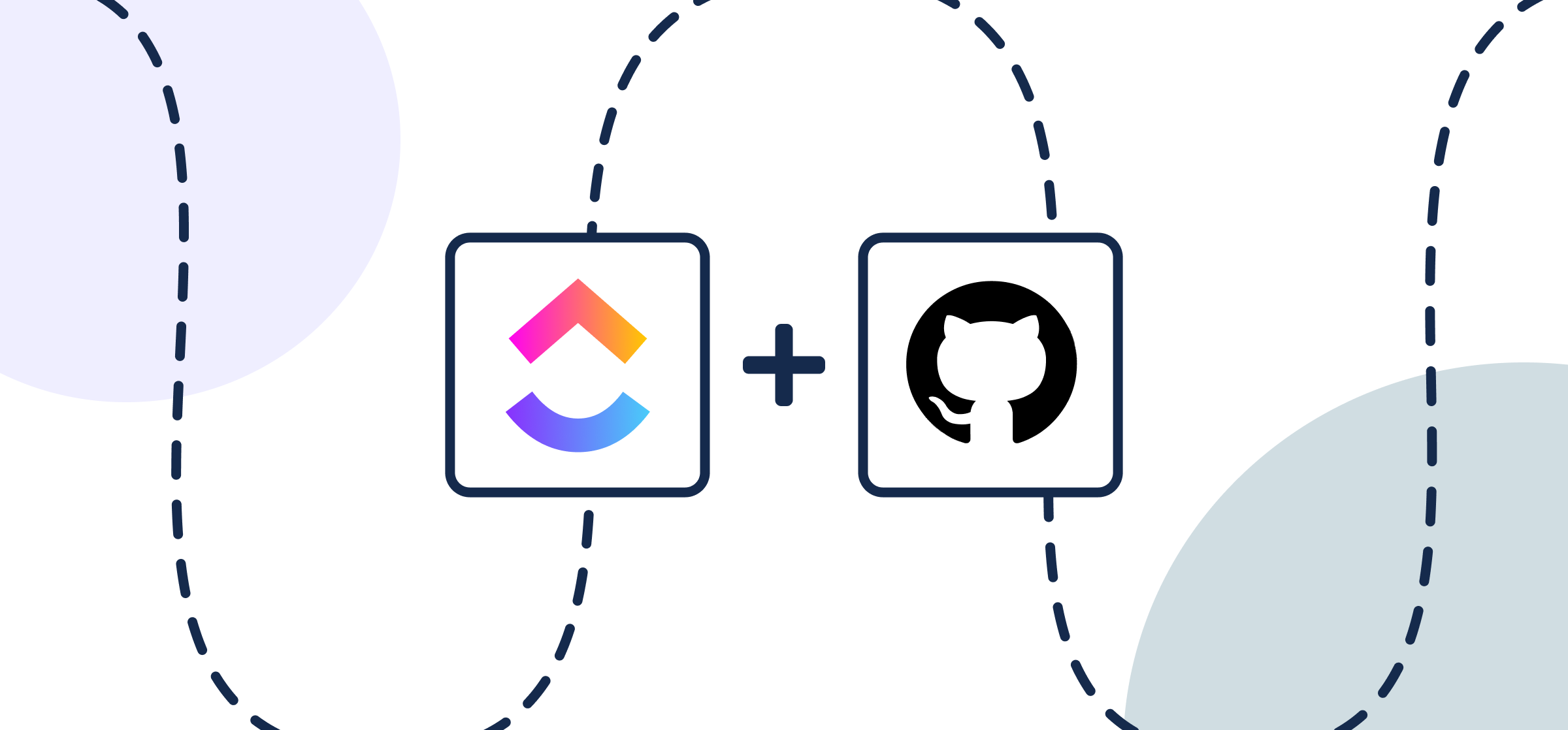How to Quickly Connect ClickUp GitHub with Automated 2-Way Sync
This tutorial will show you how to quickly set up a no-code 2-way integration with Unito that continually pushes GitHub issues to ClickUp (or vice versa) with automated updates. It’s designed for anyone to use without needing to write script of any kind. No Groovy, no JavaScript, just a secure point-and-click interface that can be customized to your use case.
By the end of this article, you’ll have a no-code 2-way workflow that eliminates these common problems:
- Wasted time and human error caused by manual input between ClickUp and GitHub
- Lost communication between developers and other team members
- Difficulty tracking software development progress for non-technical stakeholders
Here’s what that looks like in practice:
Use this integration to streamline your software development projects, improve team communication, and gain real-time visibility into your work – without needing any coding knowledge.
By the end of this article, you’ll be able to create tasks in GitHub and issues in ClickUp that will then be synced together in real-time. So any manual changes you make to a ClickUp task or GitHub issue will automatically be reflected in the other.
In this article:
- Step 1. Connect GitHub and Clickup to Unito
- Step 2. Choose a flow direction for creating new issues or tasks
- Step 3. Filter out unrelated ClickUp tasks and GitHub issues with rules
- Step 4. Link fields between ClickUp and GitHub
- Step 5. Launch your ClickUp – GitHub integration
- FAQ: GitHub ClickUp integration
Key Takeaways
- Integrate ClickUp with GitHub to centralize task management and coding in one space, boosting productivity and communication across the board.
- This 2-way ClickUp GitHub integration enables real-time updates for fast information sharing, making it optimal for both project managers and development teams.
- Unito is flexible tool that streamlines workflows for variety of roles and use cases, including tracking ticketing progress or aligning comments and other fields.
Note: You must be a GitHub admin or organization owner in order to connect GitHub to Unito.
Step 1. Connect GitHub and ClickUp to Unito
Navigate to the Unito App and select +Create Flow. On the next screen, select Start Here to connect your GitHub repository and ClickUp list.

In the above example, we’ve connected ClickUp tasks from the list: “Dev Collab” with GitHub issues from the repository: “Feature requests”.
When you’re ready, select Confirm.
Connecting GitHub to Unito for the first time
If this is your first time connecting GitHub to Unito, you’ll need a GitHub admin or organization owner to complete a few extra steps to choose which GitHub organization(s) you wish to sync issues from.
Click to expand for GitHub setup instructions
- First, you’ll be prompted to select an organization or your personal GitHub account. Chooes the organization you plan on syncing.
- On the next screen, you can choose to sync issues from specific repos within that organization, or issues from all repos. Choose whichever option you prefer.
If you can’t complete this process for any reason, don’t hesitate to reach out to our live support team.
Step 2. Choose a flow direction for creating new issues or tasks
Your data can sync either from ClickUp to GitHub, GitHub to ClickUp or both simultaneously. Each tool can become a source and/or destination for Unito. This determines how manual activity in one app will automatically create and update information in another.
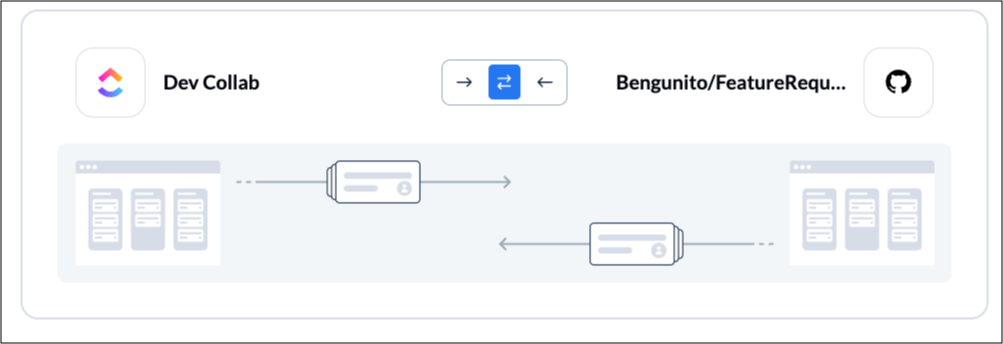
Note: Regardless of flow direction here, we’ll also set a separate sync direction for individual fields in Step 4.
Select Confirm when you’ve chosen a flow direction.
Step 3. Filter out unrelated ClickUp tasks and GitHub issues with rules
This is where you can set up conditions to filter out tasks or issues that you don’t want to sync with Unito. If you don’t set any rules, then all ClickUp and GitHub data will sync between your chosen list and repo. A great way to filter information is through the use of labels or tags.
Select Add a new trigger to get started.
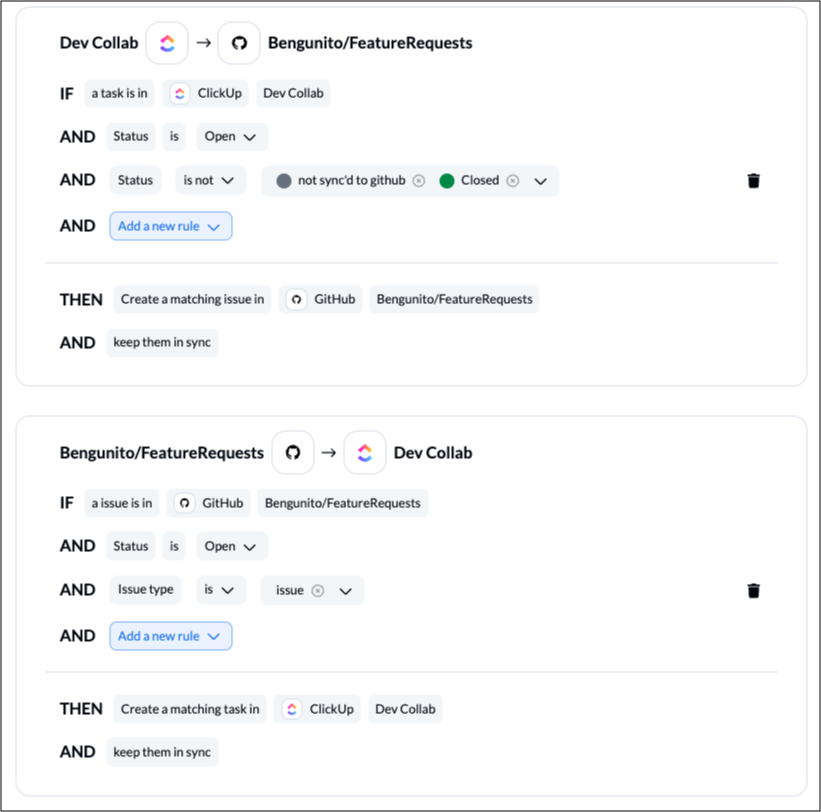
Find out more about setting rules.
Step 4. Link fields between ClickUp and GitHub
Fields represent the details of your ClickUp tasks and GitHub issues. Comments, due dates, assignees, descriptions, etc. all count as fields in Unito.
What are Field Mappings?
First, you’ll be asked whether you want to set up your fields from scratch or let Unito do so automatically. If you select auto-map, you can still change any mappings you want afterwards. If you prefer a DIY approach, start from scratch.
Your fields will be automatically mapped for two-way updates, but you can modify each individually if you prefer a one-way sync in some cases. A two-way update means that changes from either ClickUp or GitHub will be applied to the other. A one-way update restricts those changes accordingly.
Select + Add mapping, then Select a field in both GitHub and ClickUp to pair two fields together.
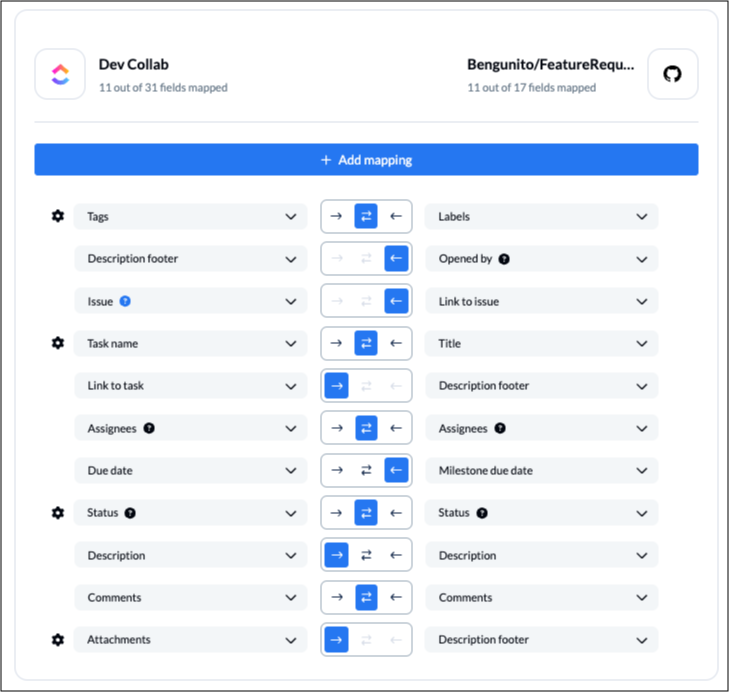
You can select any field with a gear icon to add an additional layer of customization through values (options within a multi or single-select field):
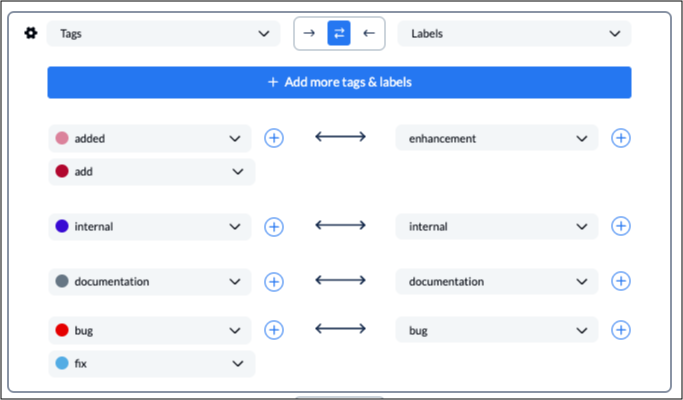
You can add your own layers of complexity in each tool however, in case you have a variety of statuses you’d like to map here.
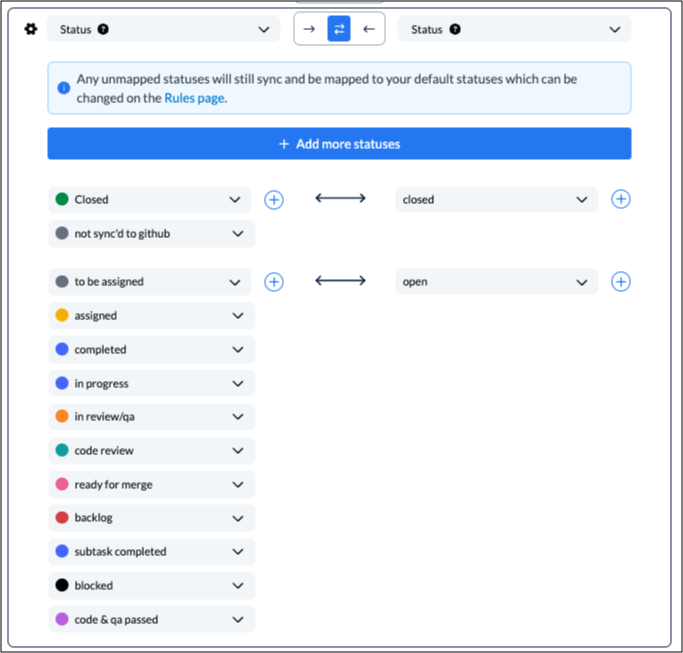
Click Confirm when you’re satisfied with your field mappings to proceed.
Step 5. Launch your ClickUp – GitHub integration
And that’s it! You’ve just completed a flow between GitHub and ClickUp. Congratulations!
If you’ve followed the steps above, your flow will now:
- Create an issue in GitHub based on ClickUp tasks from our specified project.
- Enable technical and non-technical teams to collaborate between ClickUp and GitHub with a view on task progress.
What’s next after a 2-way ClickUp GitHub integration?
If you’re interested in seeing what else you can do with Unito, here are some articles to help you power up your workflows:
- Need some inspiration? Here’s how the team at B&H Photo uses a ClickUp Jira workflow to collaborate on dev work.
- You can duplicate this flow to build a more powerful workflow by sending ClickUp tasks to other GitHub repos for different purposes, perhaps one for bug fixes and another for feature requests.
- Having issues with your issues? Check out Unito’s Troubleshooting Guide for GitHub users.
- Follow these links to better understand each integration’s capabilities and limitations: GitHub and ClickUp.
FAQ: ClickUp GitHub integration
Why connect a ClickUp GitHub integration?
Are you juggling projects with team members who prefer different tools? Do you waste time manually copying updates between ClickUp and GitHub? If so, a no-code integration platform like Unito can help.
ClickUp is a superb task management tool with a range of useful features to enhance collaboration among teams and departments. But, when it comes to software development and coding, there’s no getting around the need for a dedicated open-source platform such as GitHub.
You can also use this workflow to streamline software development management; the ticketing progress; or to align comments, assignees, custom fields, and more.
The power of open-source projects and collaboration
Open-source projects have transformed the way developers work around the globe, particularly when it comes to collaboration. But collaboration comes with its own challenges, particularly if you have teams in multiple tools and physical locations.
Connecting ClickUp to GitHub with a no-code integration platform such as Unito eliminates the need for someone on your team to manually check repos or projects for updates. This can be useful for quickly submitting bug reports or feature requests, supporting software development teams, coordinating work between dev teams and the rest of your organization, and so on.
Streamlining Workflows with Unito’s No-Code Integration
This ClickUp GitHub Integration can also be useful in setting up a more efficient way of working across complex initiatives and work with remote teams more easily. Instead of having to wait hours or days for updates to come through manually, you’ll see live updates in whichever tool you prefer.
How do I get the most out of a GitHub ClickUp integration?
- Create, assign, and track development-related tasks within ClickUp. Changes automatically sync to GitHub.
- Visualize progress using ClickUp dashboards, Gantt charts and Kanban boards . Customize rules to filter what gets synced, ensuring only relevant information flows between the platforms.
- Add reporting tools to get richer reports.
Who should integrate GitHub and ClickUp with Unito?
Imagine a scenario where developers push code updates and those changes are immediately reflected in the project’s docs on ClickUp. Stakeholders can address concerns, add input, and stay updated in real-time. This seamless synchronization is not just a feature—it breaks down barriers and builds bridges where data silos once stood.
Unito offers a simple and user-friendly experience without added complexity, allowing you to easily navigate through various categories. Any team that relies on GitHub issues can benefit, including:
- Tech Companies: Streamline bug tracking and feature requests coming from non-technical teams.
- Agencies: Keep clients informed of development progress within ClickUp while your devs work in GitHub.
Instead of asking someone to work in an unfamiliar interface, you could simply create a task in ClickUp with details about the request and watch that information turn into a GitHub issue automatically.
Product managers
Create a centralized view of user feedback, collating it in ClickUp and syncing it with the development process on GitHub. Product managers create systems that efficiently channel user feedback in ClickUp directly into the GitHub development pipeline. Additionally, agencies and freelancers use the integration through Unito to better handle projects, syncing vital information and project updates to ensure they’re always ahead of the game.
Project managers
Gain real-time visibility into development progress without needing to learn GitHub. Track bugs, feature requests, and more within your familiar ClickUp interface. Project managers leverage the integration to automate repetitive tasks between ClickUp and GitHub, saving significant time and enhancing project efficiency.
For streamlining software development management processes, the ClickUp-GitHub integration is invaluable. By centralizing the management of tasks and projects across various GitHub repositories, it simplifies complex workflows for teams working on multiple projects simultaneously.
Software development teams
This integration allows developers to focus on coding, while project managers can effectively track progress, creating a streamlined and efficient development workflow. Collaborate seamlessly with non-technical team members directly in GitHub, without constantly context-switching tools.
Does this integration provide centralized information for remote teams?
Yes! Stay aligned with updates automatically reflected in both tools, regardless of where team members are working. Remote and distributed teams particularly benefit from the ClickUp-GitHub integration, as it allows them to:
- Manage tasks and collaborate on code within a single platform
- Reduce the need to switch between different platforms
- Ensure that all team members are always on the same page, no matter their location.
Does ClickUp have GitHub integration?
Yes, ClickUp has GitHub integration available on every plan, allowing repository admins to add GitHub repositories to ClickUp for Workspace admins to use in Spaces.
Does ClickUp integrate with bitbucket?
Yes, ClickUp integrates with Bitbucket, but only Workspace owners and admins can set up the integration, and guests can’t use it…Unless you sync with Unito.
What is the purpose of integrating ClickUp and GitHub?
Integrating ClickUp and GitHub helps streamline task management, enhance collaboration, and centralize information for teams, especially benefiting project management and software development workflows. Unito eliminates the need for manual updates, boosting efficiency and reducing friction between your teams.
How does Unito enhance a ClickUp GitHub integration?
Unito enhances a ClickUp GitHub integration by enabling real-time synchronization of tasks and issues, offering no-code setup, and providing a centralized platform for project management and development, making it particularly useful for remote teams.
Can non-technical team members benefit from the ClickUp-GitHub integration?
Absolutely! The ClickUp-GitHub integration allows non-technical team members to collaborate seamlessly across platforms, making project details and updates accessible to everyone on the team without requiring technical expertise.
Why do I need to link fields between ClickUp and GitHub?
The act of linking fields between ClickUp and GitHub doesn’t just sync your data, it also harmonizes it. Unito enables real-time data synchronization between fields including:
- task title
- description
- status
- priority
- due date
- comments
- assignees
Your data can be synchronized to maintain consistency across platforms—ensuring that no matter where you are working or when you visit, you have the full, updated picture with custom views.

Simply select ‘+ Add mapping’ and pair fields from ClickUp with corresponding fields in GitHub. These links are the threads that weave together your project management and development efforts.

